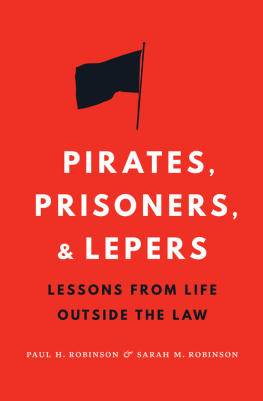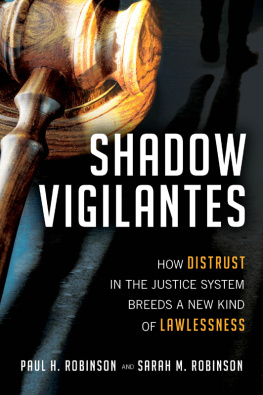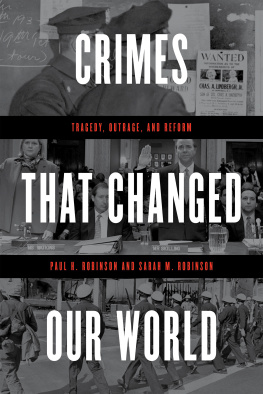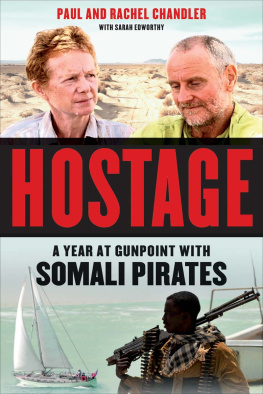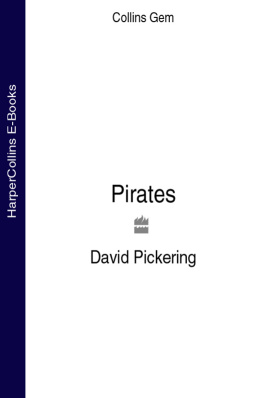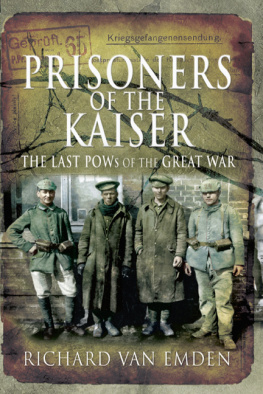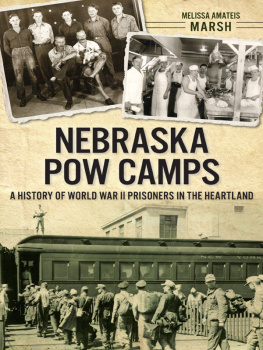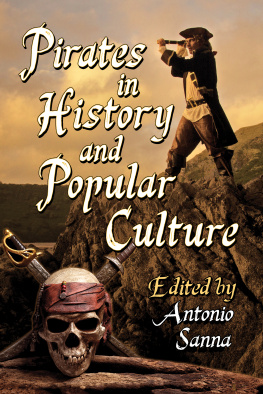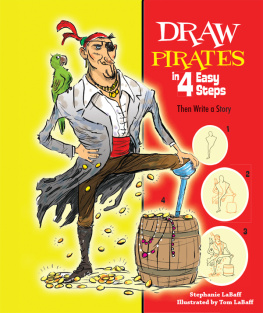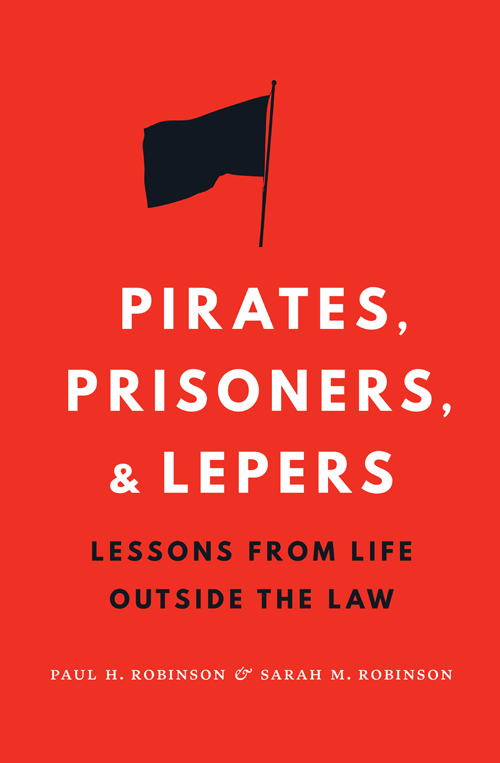
This engaging book blows the top off the tired old argument over whether humans are selfless do-gooders or relentless self-interest machines.... With a series of lively, surprising, and entertaining examples of how we actually behave when the veneer of civilization is gone, this book is a must for anyone who has wondered whether government interferes with our inherently good natures or restrains our inherently bad ones.
Morris Hoffman, state trial judge, member of the MacArthur Foundation Research Network on Law and Neuroscience, and author of The Punishers Brain
Ive been a fan of Paul Robinsons writings on criminal justice for many decades. This book brings his brilliant scholarship to a wider audience in the context of criminal justice issues that affect us all.
Alan Dershowitz, author of Taking the Stand: My Life in the Law and professor emeritus of law at Harvard University
Paul Robinson, perhaps the nations leading criminal law scholar, has produced a book that raises profound issues while suggesting practical legal reformsand he does so in a remarkably entertaining way.
Paul G. Cassell, former federal judge and Ronald N. Boyce Presidential Professor of Criminal Law at the S.J. Quinney College of Law at the University of Utah
Hobbes said a society without punishment would be a jungle. Some modern day academics have suggested it would prove to be a paradise, if we would only give it a chance. Who is right? Both and neither, as Paul and Sarah Robinson show with the help of some extraordinary, insufficiently appreciated natural experiments.... Here we learn how justice emerges from nature red in tooth and claw.
Leo Katz, author of Why the Law Is So Perverse and Frank Carano Professor of Law at the University of Pennsylvania
Fun, fascinating, and full of insight: Pirates, Prisoners, and Lepers will make you reconsider what you think you know about government and its relationship to social order.
Peter T. Leeson, author of Anarchy Unbound and Duncan Black Professor of Economics and Law at George Mason University
Pirates, Prisoners, and Lepers
Pirates, Prisoners, and Lepers
Lessons from Life Outside the Law
Paul H. Robinson and Sarah M. Robinson
Potomac Books
An imprint of the University of Nebraska Press
2015 by Paul H. Robinson and Sarah M. Robinson
Cover designed by N. Putens
Author photos by Sameer Khan, courtesy of Penn Law
All rights reserved. Potomac Books is an imprint of the University of Nebraska Press.
Library of Congress Cataloging-in-Publication Data
Robinson, Paul H., 1948, author.
Pirates, prisoners, and lepers: lessons from life outside the law / Paul H. Robinson and Sarah M. Robinson.
pages cm
Includes bibliographical references and index.
ISBN 978-1-61234-732-5 (hardback: alk. paper)
ISBN 978-1-61234-744-8 (epub)
ISBN 978-1-61234-745-5 (mobi)
ISBN 978-1-61234-746-2 (pdf)
1. Criminal lawPhilosophy. 2. Criminal justice, Administration ofPhilosophy. 3. PunishmentPhilosophy. I. Robinson, Sarah M., author. II. Title.
K 5018. R 6595 2015
340'.115dc23
2014050161
The publisher does not have any control over and does not assume any responsibility for author or third-party websites or their content.
Dedicated to the 125,000 human generations,
and especially ours.
From
John Dale McAlpine
(born 1931)
to
Devlin and Austin Robinson and Charlie and William Hart
(born 2010 to 2013)
Contents
T HIS PROJECT HAS BEEN IN THE WORKS FOR MANY YEARS, AND IN that time we have become indebted to many people. The book reveals the power of human cooperation and we found that and more in strangers and friends alike all over the world.
Our greatest debt goes to the staff and administrators at Penn Law, including Michael A. Fitts, dean; Merle J. Slyhoff, of library collection development and resource sharing; Edward Greenlee, associate library director for public services and adjunct professor of law; Silvana Burgese, manager of faculty support services; her deputy, the amazing Kelly Farraday; and the wonderful Jennifer Evans.
We have been helped over the years by a string of excellent research assistants, including Missy Kramer, Rebecca Blake, Brandon Kenney, Samantha Jacoby, Matt Majarian, Stephanie Wering, Daniel Wilson, Danby Kim, Aaron Ellias, Keenan Lynch, and Heather Blue.
Historians and curators from many corners have helped us find sometimes impossible sources. We are especially indebted to Pennie Moblo, instructor, Lane Community College, and curator of Molokai Archives; Anne Crawford, dean of Akitsiraq Law School, Netsilik; Colville Petty, curator of Heritage Collection Museum, Anguilla; Bob Conrich, a historian in Anguilla; Richard Featherstone, associate professor of criminology and associate dean of the college of social and behavioral sciences, University of Northern Iowa (for his materials relating to Attica); and Sylvia Garnet, mother of Ryan Holle.
Gathering the photographs for the book was another grand adventure. We received help from as far away as Australia with the Western Australian Museum providing the picture for the Batavia story. Rodrigo Dellutri, our Argentine visitor, was able to reach out to Nando Parrado for pictures from his time in the Andes. Closer to home, Richard Kallweit, formerly of Drop City, graciously shared some of his photographic memories. Sylvia Garnet, mother or Ryan Holle, and Mike Schafer, brother of Mary Ann, were also kind enough to help us tell our story with personal photographs of their loved ones.
Many of our friends have taken the time to read and comment on drafts of chapters as we shaped them for a general audience, including Reinheld Muenke, Nancy Bray, Carol Baker, Anita Friday, John McAlpine, George Sevier, Leo Katz, and Stephanos Bibas.
What Is Our Nature?
What Does Government Do for Us and to Us?
O N A SUNNY J UNE MORNING, THE PARENTS OF PRESCHOOLERS AT an elementary school in Los Angeles gather to celebrate the graduation of their twenty-three little ones. The cheery sky-blue walls of the classroom with its tidy bulletin boards welcome the parents, mostly mothers, to an endearing ceremony. It is followed by a photo session with each graduate posing in a cap and gown a photo to memorialize the youngsters start down the path to what all hope will be a life of success and happiness.
But the mother of the most recently photographed child seems to be taking a bit too long removing the cap and gown from her child, at least in the view of the next mother in line. Mother Next comments on this, showing some frustration. Mother First responds with a less-than-sympathetic remark. Mother Next gives Mother First a shove. Mother First shoves back, and fists begin to fly. The mayhem quickly spreads into three separate fights, then into a general brawl. A few parents step clear of the brawl and three take out their cameras to record the action.
A well-put-together young mother with a tight bun hairstyle runs toward the fight but is grabbed by a mother in a white blouse. Nice Bun breaks free by shedding her jacket. White Blouse is left holding an empty pink windbreaker as Nice Bun tackles Striped Shirt, who had been randomly pummeling those around her. The slapping and punching sounds are clear on the recordings, with children heard screaming in the background.

